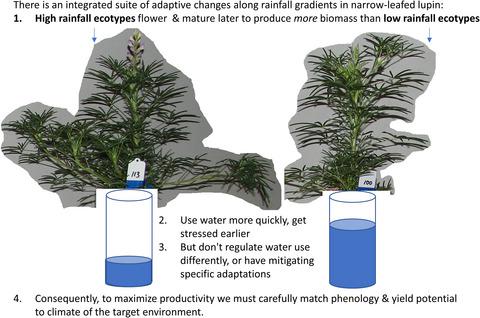当前位置:
X-MOL 学术
›
Plant Biol.
›
论文详情
Our official English website, www.x-mol.net, welcomes your
feedback! (Note: you will need to create a separate account there.)
Changing water use and adaptive strategies along rainfall gradients in Mediterranean lupins.
Plant Biology ( IF 4.2 ) Pub Date : 2020-01-02 , DOI: 10.1111/plb.13076 J D Berger 1 , C Ludwig 1 , K Whisson 1
Plant Biology ( IF 4.2 ) Pub Date : 2020-01-02 , DOI: 10.1111/plb.13076 J D Berger 1 , C Ludwig 1 , K Whisson 1
Affiliation

|
There is growing interest in harnessing the genetic and adaptive diversity of crop wild relatives to improve drought resilience of elite cultivars. Rainfall gradients exert strong selection pressure on both natural and agricultural ecosystems. Understanding plant responses to these facilitates crop improvement. Wild and domesticated narrow-leafed lupin (NLL) collected along Mediterranean terminal drought stress gradients was evaluated under contrasting reproductive phase water supply in controlled field, glasshouse and cabinet studies. Plant phenology, growth and productivity, water use and stress responses were measured over time. There is an integrated suite of adaptive changes along rainfall gradients in NLL. Low rainfall ecotypes flower earlier, accumulate lower seed numbers, biomass and leaf area, and have larger root:shoot ratios than high rainfall ecotypes. Water-use is lower and stress onset slower in low compared to high rainfall ecotypes. Water-use rates and ecotypic differences in stress response (Ψleaf decline, leaf loss) are lower in NLL than yellow lupin (YL). To mitigate the effects of profligate water use, high rainfall YL ecotypes maintain higher leaf water content over declining leaf water potential than low rainfall ecotypes. There is no evidence for such specific adaptation in NLL. The data suggests that appropriate phenology is the key adaptive trait to rainfall gradients in NLL because of the flow-on effects on biomass production, fitness, transpiration and stress onset, and the lack of physiological adaptations as in YL. Accordingly, it is essential to match phenology with target environment in order to minimize risk and maximize yield potential.
中文翻译:

在地中海羽扇豆中,随着降雨量的变化,水资源的使用和适应策略不断变化。
利用农作物野生近缘植物的遗传和适应性多样性来提高优良品种的抗旱能力的兴趣日益浓厚。降雨梯度对自然和农业生态系统都施加强大的选择压力。了解植物对这些植物的反应有助于改善作物。在对照田间,温室和橱柜研究中,在对比生殖阶段供水的情况下,评估了沿地中海终端干旱胁迫梯度收集的野生和驯养的阔叶羽扇豆(NLL)。随着时间的推移,对植物物候,生长和生产力,水分利用和胁迫响应进行了测量。NLL中有一个集成套件,可以适应沿降雨梯度的自适应变化。低降雨量的生态型开花较早,积累的种子数量,生物量和叶面积较低,并且具有较大的根:射精率高于高降雨生态型。与高降雨的生态型相比,低水的使用量较低,应力发生速度较慢。NLL的水分利用率和胁迫响应的生态型差异(叶片下降,叶片损失)低于黄羽扇豆(YL)。为了减轻过度用水的影响,与低降雨生态型相比,高降雨YL生态型在叶片水势下降的情况下保持较高的叶片水分含量。没有证据表明NLL有这种特殊的适应性。数据表明,适当的物候是NLL中降雨梯度的关键适应性状,因为对生物量生产,适应性,蒸腾作用和应激发作的持续影响,以及像YL一样缺乏生理适应性。因此,
更新日期:2020-01-02
中文翻译:

在地中海羽扇豆中,随着降雨量的变化,水资源的使用和适应策略不断变化。
利用农作物野生近缘植物的遗传和适应性多样性来提高优良品种的抗旱能力的兴趣日益浓厚。降雨梯度对自然和农业生态系统都施加强大的选择压力。了解植物对这些植物的反应有助于改善作物。在对照田间,温室和橱柜研究中,在对比生殖阶段供水的情况下,评估了沿地中海终端干旱胁迫梯度收集的野生和驯养的阔叶羽扇豆(NLL)。随着时间的推移,对植物物候,生长和生产力,水分利用和胁迫响应进行了测量。NLL中有一个集成套件,可以适应沿降雨梯度的自适应变化。低降雨量的生态型开花较早,积累的种子数量,生物量和叶面积较低,并且具有较大的根:射精率高于高降雨生态型。与高降雨的生态型相比,低水的使用量较低,应力发生速度较慢。NLL的水分利用率和胁迫响应的生态型差异(叶片下降,叶片损失)低于黄羽扇豆(YL)。为了减轻过度用水的影响,与低降雨生态型相比,高降雨YL生态型在叶片水势下降的情况下保持较高的叶片水分含量。没有证据表明NLL有这种特殊的适应性。数据表明,适当的物候是NLL中降雨梯度的关键适应性状,因为对生物量生产,适应性,蒸腾作用和应激发作的持续影响,以及像YL一样缺乏生理适应性。因此,










































 京公网安备 11010802027423号
京公网安备 11010802027423号